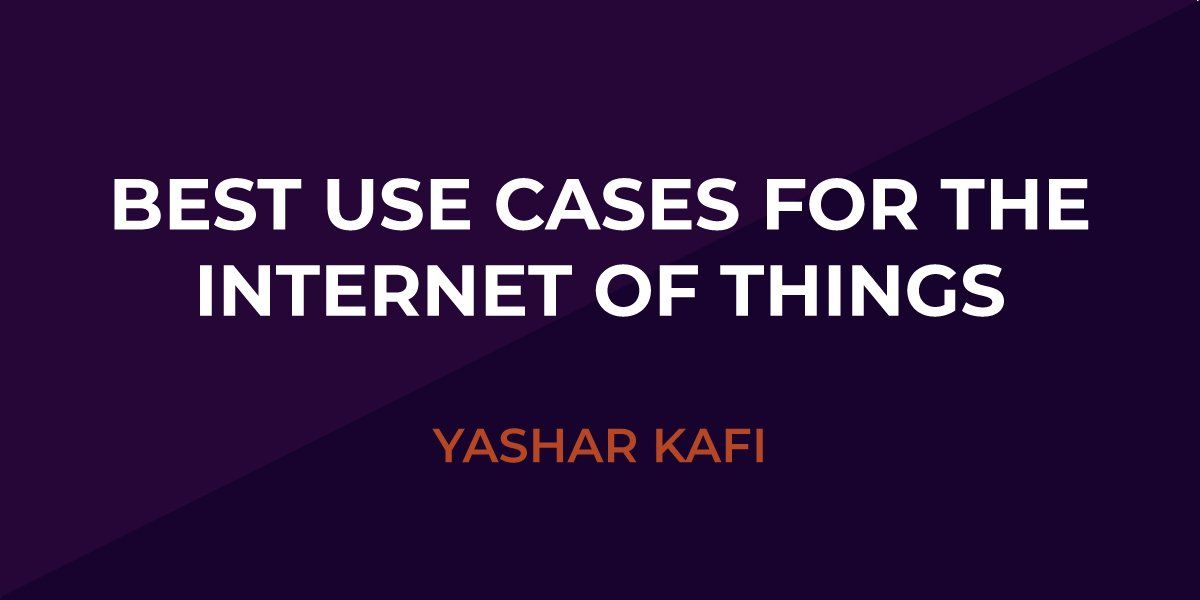Best Use Cases for the Internet of Things
By Yashar Kafi
When I hear, The Internet of Things (IoT), I can’t help but think it refers to “smart” refrigerators, “smart” thermostats, and the Apple Watch. Day-to-day machines, accessories, or just “things” that are connected to the Internet and harvest data in some way are all part of the Internet of Things’ web. The C-Suite within most organizations probably already know that they need to invest in the IoT; smart technology is great, after all. The thing is, they probably don’t know what the smartest move is for process enhancement.
Here are five of the top use cases for IoT, with potential use for many businesses:
Five Of The Best Use Cases
IoT is redefining the way that we interact with the world around us; in the house, we now have the next evolution of light bulbs, thermostats, washing machines, dishwashers, refrigerators. The day-to-day applications are changing, sometimes literally through the use of an application ─ “Alexa turn on the oven to bake at 400” which can control all of the above! You’ll even find the IoT interwoven throughout cities now, with smart motorways, cameras, and sensors everywhere, to reduce traffic congestion and the subsequent pollution from vehicles.
Companies like Tesla are founded on the very concept of the IoT ─ their cars, most of which are electric, depend on the collation of data (and, a lot of it ) to drive innovation and advancements in products. Their cars can even talk to each other and provide vehicle performance settings, determine traffic information and speed adjustments based on another vehicle.
Healthcare:
The Internet of Things has disrupted the healthcare industry in more ways than one, but one of the greatest developments – a milestone, if you like – is the ability for doctors and nurses to track the health and status of individual patients from afar. Remote patient monitoring has advanced to the point where the relevant people can see your vitals, MRI results, as well as whether you’re taking the right medication at the right time, from anywhere with an internet or cell signal. They can also track your healing progress with applications that will immediately alert them when something changes
Retail and Supply:
We all want an app that’ll solve all of our problems, right? When it comes to inventory or stock, there is now one! The IoT brings a ton of sensors together across a supply chain, tracking every single product or item and monitoring its state ─ throw Blockchain tech on top of this and you’ve got a whole new avenue to explore.
It isn’t only great for that, though. It can also tell you exactly how many products you’ve got on the shelf, in the warehouse, and it’ll even automation ordering, processing, and logistics for you.
Manufacturing and Production
In this game, with the right IoT-enhanced tools in place, your entire factory can automatically communicate and react with every other piece of tech inside. It’s like a little hive-mind of automation. You cut waste, expenses, time, and resources with a whole suite of kit that involves absolutely no human input.
Logistics
In logistics, it’s all about schedules, inventory management, travel, and timing; the IoT has made it so that, if you’ve got the right tools in your fleet of vehicles, you can track them as they go about their business. It could be a taxi, a take-out delivery car, or a truck full of goods ─ they can all be tracked in real-time. Many organizations have even implemented automated tech that maps the best routes for drivers to take, ensuring fuel efficiency and punctuality. The Internet of Things is all about efficiency and making life easier, that’s for sure.
Predictive Maintenance
As you can tell, the IoT has made a big difference to several incredibly important – world-running – industries. There’s another undeniable use case for it, which a myriad of businesses already depends on ─ predictive maintenance. If your organization relies on any sort of hardware, you probably already know that it costs a bomb to maintain and, potentially, fix. The IoT is kind to us and is able to identify when your hardware requires a service and will tell you exactly when to perform your maintenance, avoiding both unnecessary expense and potential downtime.
The Internet of Things is here to stay and, as the days go by it continues to spread its roots into all of the day-to-day processes that we know and love. From the collar around your dog’s neck to the coffee machine at work, you’re surrounded by innovative technological advances. Experts are predicting that this year, 2020, will see more than 65% of new businesses adopting IoT products to improve their business operations. At AMPlify , we want to start a discussion about IoT implementation and how it’s affected your business processes already, so, drop a line in the comments and let’s get chatting!




